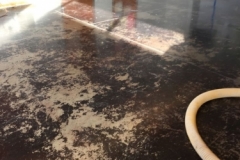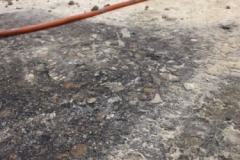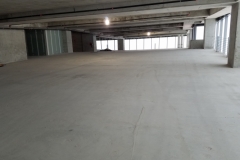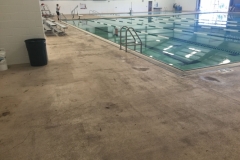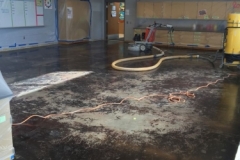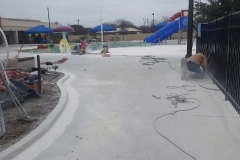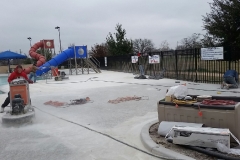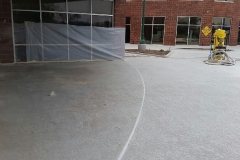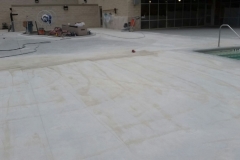Concrete Surface Preparation
Two of the main factors impacting the service life of concrete are cracks and a lack of adhesion of a floor system to a concrete substrate. That’s why the quality of your surface preparation is absolutely critical to determining whether any type of concrete repair project is a success. Whether you are looking for a contractor to perform epoxy removal, coating removal, tile removal, glue removal or get your surface ready for any other type of flooring application, AllStar Concrete Coatings has the right equipment and experience to get the job done right and on time.
Schedule ConsultationBenefits of Choosing AllStar
- A full-service concrete contractor with a thorough understanding of all the different concrete surface preparation techniques to advise you on which are best for your job.
- Company-owned and maintained specialty floor grinders, shot blasters, and dust collectors to ensure your project is completed to the highest standards.
- Qualified, experienced crews to ensure that you have the right foundation—quite literally—for a surface that will match your desired performance requirements.
- A commitment to minimizing the disruption to your business operations and avoiding excessive downtime.
- A proven track record of delivering lower maintenance, easy to clean, and maintain new surfaces that can last longer and look better than your current concrete slab.
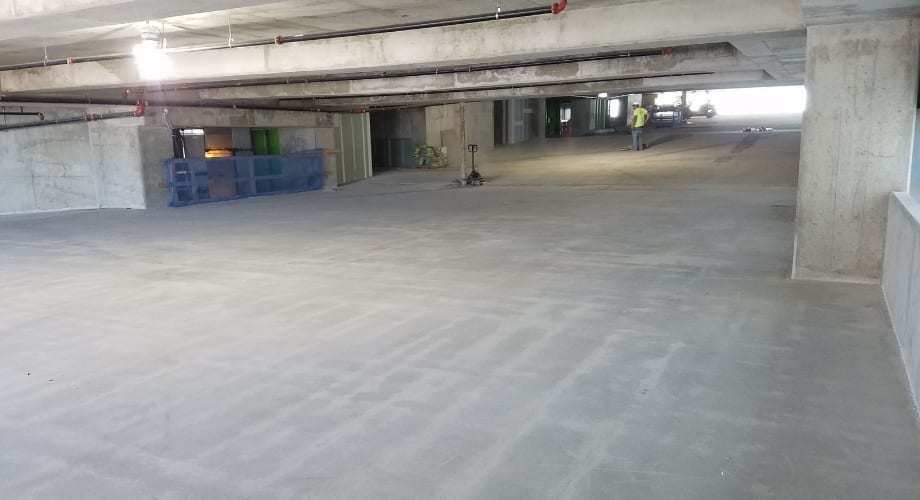
Parking deck prepped with concrete grinder
Surface Preparation We Offer
Although concrete surface preparation can be a tedious, messy, and time-consuming process, the importance of this step in a concrete repair project glue removal, or epoxy removal cannot be overstated. The technique or techniques used to achieve a good and lasting bond between the concrete substrate and the repair material will depend upon the thickness of the new overlay you choose and the performance demands of your space.
We follow the International Concrete Repair Institute’s Concrete Surface Profile (CSP) classifications when advising customers on what type of surface prep will be best for their needs. This scale goes from CSP 1, which corresponds with an almost flat surface, to CSP 9, which is the roughest texture. Each classification requires a slightly different technique and equipment to obtain, and some are more suitable for certain types or thicknesses of coatings than others. In general, the thicker the overlap, the higher the CSP number needed to ensure proper adhesion.
AllStar may recommend one or more of the following surface prep methods for your project. These techniques are listed from the most gentle to the most aggressive:
Detergent Scrubbing & Low-Pressure Water Cleaning
When only minimal surface prep is required to a surface, we can use a combination of different types of chemical cleaners to remove existing adhesives, grease, oil, dirt, wax, rust, some glue removal acrylic, and other surface contaminants. The profile of the surface will remain largely unchanged after performing this service, so this can help you get to a CSP 1.
Acid Etching
Using this method, we apply a mixture of water and either citric acid or muriatic acid using a low-pressure sprayer to the surface of the slab. This process chemically removes any cement paste that is on the surface and exposes the fine aggregate. This technique is generally recommended for micro-toppings since it results in only a slightly altered surface profile and can expose other contaminants. This service can help you reach the CSP 1, 2, or 3 classification level.
Grinding
Another concrete resurfacing technique is grinding, which can make the surface more level by evening out imperfections and removing thin-set coatings, underlayments, self-leveling overlays, epoxy removal, carpet demo, glue removal, tile removal, and any mineral deposits on your concrete. Our heavy-duty grinders have diamond-impregnated blades that travel across the surface at right angles under pressure. Although grinding will help smooth out the concrete surface, you’ll need to incorporate another technique to achieve a CSP 1, 2, or 3.
Abrasive Blasting
Air compressors are used to blast particular media unto the surface in a sweeping, controlled motion for a varying amount of time, based on your objectives. You can use this method on vertical, horizontal, and even overhead surfaces. Abrasive blasting can achieve a resulting profile of between 2 and 4 CSP.
Shot blasting
Sometimes considered the most cost-effective way to prepare your concrete for a new surface, this method is typically used to roughen a surface prior to applying a polymer overlay or thick coating, although it can also be used to remove tile mastics, epoxy coatings, and polyurethane coatings. Shotblasting machines use centrifugal force to push steel shot onto your surface at high speeds to fragment the top layer. All of this occurs inside of a closed chamber, which is a big advantage as this process produces only minimal airborne debris and dust. The size of the shot you use, the way you set up the machine and the actual speed at which the shot is launched will dictate the depth of your removal. This technique works well for a CSP texture of 2, 3, 4, 5, 6, 7, or 8.
Scarifying
Specially-designed attachments can be added to grinders for glue removal and thicker coatings. Almost all of the dust produced during this process is usually removed via dust containment systems. Scarifying can help you reach a CSP of 4, 5, 6, 7, 8, or 9.
Needle Scaling
Needle scaling may be recommended for applications that are usually impractical using other methods, including in tight spaces and along surface edges. This type of surface preparation is performed by using a hand-held tool that is equipped with steel rods that are pressed into the surface when the operator squeezes the needle gun trigger. You can expect a resulting surface profile between CSP 5 and 8.
Scabbling
This technique involves applying cutting heads powered by pistons to the substrate at right angles to remove rigid coatings and deteriorated concrete that is less than ¼ inch in thickness. The resulting surface texture ranges from a CSP 7 to CSP 9. One drawback of scabbling is that it can cause microcracks in your concrete which can negatively impact the ability of the substrate to bond with a new surface. To address this issue, contractors usually combine this method with either abrasive blasting, high-pressure water blasting, or shot blasting. Scabbling may be recommended if you need to obtain CSP 8.
Milling
Both milling and roto milling can remove the thickest surfaces for the most involved surface preparation projects. This method results in a coarse, fractured aggregate surface that is usually the highest measure of texture on the CSP scale: 9. Because this process involves heavy machinery and a high level of impact, it is only used in limited cases.
Mechanical profiling—shot blasting, bush hammer, grinding, and scarifying, either on their own or in conjunction—is often what we recommend to address spalled concrete, epoxy removal, and most glue removal, resinous coatings, and concrete sealer so that you can lay down a new surface.
When considering which concrete surface preparation technique will be best, we balance the desired outcomes the home or property owner is seeking with practical concerns, including:
- Avoiding damage to the structure which will be coated
- Preventing any deterioration of steel reinforcements or the bond between rebar and existing concrete
- Ensuring the impact of the chosen method will not compromise the concrete’s structural integrity
What will you gain by investing in surface preparation? Surface prep will:
- Smooth out rough spots
- Address surface irregularities
- Correct edge curling
- Remove unwanted or worn finishes or coatings
- Pave the way for more extensive repairs to your concrete
- Provide you with a uniform surface to better accept any type of new overlay or coating
- Remove existing coatings, glue removal, or epoxy demo
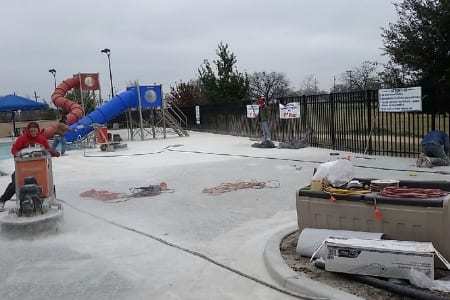
pool deck coating removal
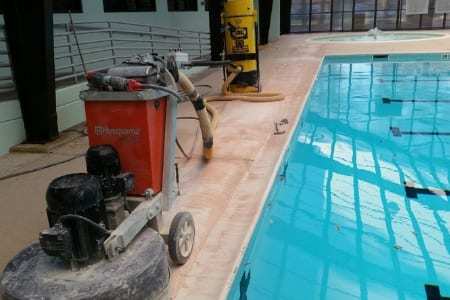
Grinding the Concrete on indoor pool deck
How Surface Preparation Works
Are you ready to get started on your concrete surface preparation project? You start the process by either giving us a call or filling out our Schedule Free Consultation form. Either way, we’ll be in touch soon to learn more about your project. Gathering some key information from you will be vital to providing you with informed recommendations about what surface prep is most appropriate for your space.
After we send along with a free, no-obligation estimate, you’ll have the opportunity to review it and ask any questions you might have. Once we hear back from you that you are ready to get started, we can reserve the crews and equipment we’ll need for your job.
Although the time spent on preparing your surface will vary widely, depending on your actual project, AllStar follows a similar series of steps on our surface prep jobs:
- Assess your current surface to determine the degree of laitance removal we will need to plan for by performing moisture and strength testing, oil and grease testing, and any other needed evaluations.
- Thoroughly clean your surface of all oil and grease, curing agents, dirt, dust, and debris. Power washing can remove some of these materials and we may use other cleaning agents to address chemical stains.
- The surface is profiled, based on the methods outlined in the project plan. Some techniques can remove contaminants while also creating the texture that will be optimal for proper adhesion of your new surface.
- We perform any needed repairs by scraping or grinding the surface, filling in any voids or cracks that appear, and removing any associated debris.
Since concrete surface preparation is often a means to an end, customers then choose a new surface that we can then install, whether it’s polished concrete, stained concrete, epoxy coatings, industrial coatings, or another type of flooring application.
Throughout the process, we will be in close communication with you through the project foreman, who will supervise the day-to-day activities of the crew assigned to your job and make sure your project is completed to your satisfaction. The foreman will also be in charge of getting all the needed equipment on the job site, as well as bringing an auxiliary power source if needed.
After we have completed any final repairs, we will schedule a meeting to review the work we have done and to schedule any needed follow-up services.
Free Consultation
Ready to learn more about how AllStar can help you? Take advantage of our free consultation to get the ball rolling.
Get Started

